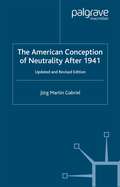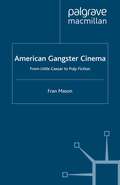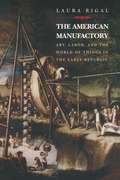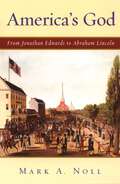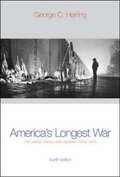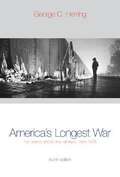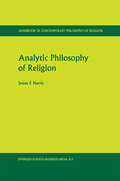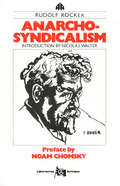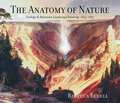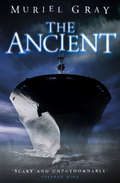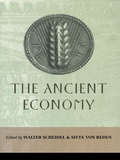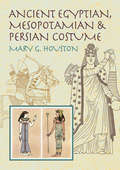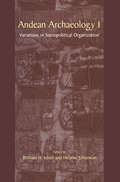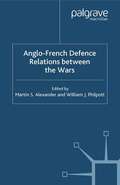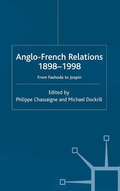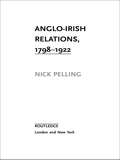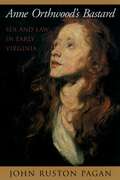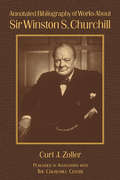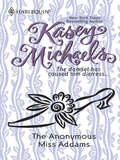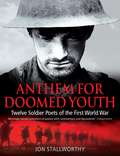- Table View
- List View
The American Conception of Neutrality After 1941
by J. GabrielThe American Conception of Neutrality After 1941 by Jürg Martin Gabriel, is a study of global political history since 1941 with a particular emphasis on America's attitude to neutrality. This important revised and updated edition contains three entirely new chapters including an insightful new introduction and conclusion, drawing on newly released documentation, most importantly on Southeast Asia and the Vietnam War. Like the previous edition, this book looks at world affairs through the eyes of neutrality. It covers, amongst other issues, America's contribution to the decline of world-neutrality, the major economic and military events surrounding the Second World War, the founding of NATO and the problems of neutralism during the Vietnam War. This new edition, however, goes one step further to confirm, with fresh new evidence, e.g. the end of the Cold War and the Unification of Germany, the central thesis of the original volume. American foreign policy is an important topic of continuing interest.
American Gangster Cinema: From "Little Caesar" to "Pulp Fiction" (Crime Files)
by F. MasonMuch analysis of gangster movies has been based upon a study of the gangster as a malign figuration of the American Dream, originally set in the era of the Depression. This text extends previous analysis of the genre by examining the evolution of gangster movies from the 1930s to the contemporary period and by placing them in the context of cultural and cinematic issues such as masculinity, consumerism and technology. With a close examination of many films from Scarface and Public Enemy to Reservoir Dogs and Pulp Fiction , this book provides a fascinating insight into a topical and popular subject.
The American Manufactory: Art, Labor, and the World of Things in the Early Republic
by Laura RigalThis cultural history of American federalism argues that nation-building cannot be understood apart from the process of industrialization and the making of the working class in the late-eighteenth-century United States. Citing the coincidental rise of federalism and industrialism, Laura Rigal examines the creations and performances of writers, collectors, engineers, inventors, and illustrators who assembled an early national "world of things," at a time when American craftsmen were transformed into wage laborers and production was rationalized, mechanized, and put to new ideological purposes. American federalism emerges here as a culture of self-making, in forms as various as street parades, magazine writing, painting, autobiography, advertisement, natural history collections, and trials and trial transcripts. Chapters center on the craftsmen who celebrated the Constitution by marching in Philadelphia's Grand Federal Procession of 1788; the autobiographical writings of John Fitch, an inventor of the steamboat before Fulton; the exhumation and museum display of the "first American mastodon" by the Peale family of Philadelphia; Joseph Dennie's literary miscellany, the Port Folio; the nine-volume American Ornithology of Alexander Wilson; and finally the autobiography and portrait of Philadelphia locksmith Pat Lyon, who was falsely imprisoned for bank robbery in 1798 but eventually emerged as an icon for the American working man. Rigal demonstrates that federalism is not merely a political movement, or an artifact of language, but a phenomenon of culture: one among many innovations elaborated in the "manufactory" of early American nation-building.
America's God: From Jonathan Edwards to Abraham Lincoln
by Mark A. NollReligious life in early America is often equated with the fire-and-brimstone Puritanism best embodied by the theology of Cotton Mather. Yet, by the nineteenth century, American theology had shifted dramatically away from the severe European traditions directly descended from the Protestant Reformation, of which Puritanism was in the United States the most influential. In its place arose a singularly American set of beliefs. In America's God, Mark Noll has written a biography of this new American ethos. In the 125 years preceding the outbreak of the Civil War, theology played an extraordinarily important role in American public and private life. Its evolution had a profound impact on America's self-definition. The changes taking place in American theology during this period were marked by heightened spiritual inwardness, a new confidence in individual reason, and an attentiveness to the economic and market realities of Western life. Vividly set in the social and political events of the age, America's God is replete with the figures who made up the early American intellectual landscape, from theologians such as Jonathan Edwards, Nathaniel W. Taylor, William Ellery Channing, and Charles Hodge and religiously inspired writers such as Harriet Beecher Stowe and Catherine Stowe to dominant political leaders of the day like Washington, Jefferson, and Lincoln. The contributions of these thinkers combined with the religious revival of the 1740s, colonial warfare with France, the consuming struggle for independence, and the rise of evangelical Protestantism to form a common intellectual coinage based on a rising republicanism and commonsense principles. As this Christian republicanism affirmed itself, it imbued in dedicated Christians a conviction that the Bible supported their beliefs over those of all others. Tragically, this sense of religious purpose set the stage for the Civil War, as the conviction of Christians both North and South that God was on their side served to deepen a schism that would soon rend the young nation asunder. Mark Noll has given us the definitive history of Christian theology in America from the time of Jonathan Edwards to the presidency of Abraham Lincoln. It is a story of a flexible and creative theological energy that over time forged a guiding national ideology the legacies of which remain with us to this day.
America's Longest War: The United States And Vietnam, 1950-1975
by George C. HerringComprehensive yet concise, America's Longest War provides a complete and balanced history of the Vietnam War. It is not mainly a military history, but seeks to integrate military, diplomatic, and political factors in order to clarify America's involvement and ultimate failure in Vietnam. While it focuses on the American side of the equation, it provides sufficient consideration of the Vietnamese side to make the events comprehensible.
America's Longest War: The United States And Vietnam, 1950-1975
by George C. HerringComprehensive yet concise, America’s Longest War provides a complete and balanced history of the Vietnam War. It is not mainly a military history, but seeks to integrate military, diplomatic, and political factors in order to clarify America’s involvement and ultimate failure in Vietnam. While it focuses on the American side of the equation, it provides sufficient consideration of the Vietnamese side to make the events comprehensible.
America's Longest War: The United States And Vietnam, 1950-1975
by George C. HerringComprehensive yet concise, America’s Longest War provides a complete and balanced history of the Vietnam War. It is not mainly a military history, but seeks to integrate military, diplomatic, and political factors in order to clarify America’s involvement and ultimate failure in Vietnam. While it focuses on the American side of the equation, it provides sufficient consideration of the Vietnamese side to make the events comprehensible.
Analytic Philosophy of Religion (Handbook of Contemporary Philosophy of Religion #3)
by James Franklin HarrisWhen Gene Long, editor of Kluwer's Handbook of Contemporary Philosophy of Religion Series, first invited me to write the volume on Analytic Philosophy of Religion, I accepted with great enthusiasm. My only explanation for that enthusiasm now is that I was younger and more naive at the time. Soon after starting work on the volume, my enthusiasm was dampened by the daunting magnitude of the task. I began as a sprinter and quickly settled into the pace of a long-distance runner. Although I considered myself well read in the subject, I soon discovered that I had a great deal of research to do to be confident that I had considered all of the major contributions to the various discussions, issues, and of religion. As I read more and more problems found within analytic philosophy books and articles, I realized that I had rushed into a territory already well trodden by the angels. I am greatly impressed by the sophistication and subtlety of philosophical argument that characterize the different debates in contemporary analytic philosophy of religion. This volume covers a vast amount of material. I have endeavored to provide the fairest possible reading of different authors, and, in cases where I include my own critical evaluations and develop my own positions, I have endeavored to provide the strongest possible interpretations of the positions I criticize.
Anarcho-Syndicalism: Theory And Practice (Pluto Classics #Vol. 2)
by Rudolf RockerRudolf Rocker’s classic survey of anarcho-syndicalism was written during the Spanish Civil War to explain to the wider reading public the ideology which inspired the social revolution in Spain. It remains unsurpassed as a general introduction to anarchist thought and an authoritative account of the early history of international anarchism by one of the movement’s leading figures.*BR**BR*The present edition is unique in giving a complete facsimile reproduction of the 1938 edition as well as the corrected transcript of the epilogue to the Indian edition of 1947. It has the addition of a new biographical introduction by Nicolas Walter, in which he quotes from previously unpublished manuscript sources.
The Anatomy of Nature: Geology and American Landscape Painting, 1825-1875
by Rebecca BedellAn illuminating account of the interplay between science, religion, and nature in nineteenth-century landscape paintingGeology was in vogue in nineteenth-century America. People crowded lecture halls to hear geologists speak, and parlor mineral cabinets signaled social respectability and intellectual engagement. This was also the heyday of the Hudson River School, and many prominent landscape painters avidly studied geology. Thomas Cole, Asher Durand, Frederic Church, John F. Kensett, William Stanley Haseltine, Thomas Moran, and other artists read scientific texts, participated in geological surveys, and carried rock hammers into the field to collect fossils and mineral specimens. As they crafted their paintings, these artists drew on their geological knowledge to shape new vocabularies of landscape elements resonant with moral, spiritual, and intellectual ideas.Rebecca Bedell contributes to current debates about the relationship among art, science, and religion by exploring this phenomenon. She shows that at a time when many geologists sought to disentangle their science from religion, American artists generally sidestepped the era's more materialist science, particularly Darwinism. They favored a conservative, Christianized geology that promoted scientific study as a way to understand God. Their art was both shaped by and sought to preserve this threatened version of the science. And, through their art, they advanced consequential social developments, including westward expansion, scenic tourism, the emergence of a therapeutic culture, and the creation of a coherent and cohesive national identity.This major study of the Hudson River School offers an unprecedented account of the role of geology in nineteenth-century landscape painting. It yields fresh insights into some of the most influential works of American art and enriches our understanding of the relationship between art and nature, and between science and religion, in the nineteenth century. It will draw a broad audience of art historians, Americanists, historians of science, and readers interested in the American natural landscape.
The Anatomy of Nature: Geology and American Landscape Painting, 1825-1875
by Rebecca BedellAn illuminating account of the interplay between science, religion, and nature in nineteenth-century landscape paintingGeology was in vogue in nineteenth-century America. People crowded lecture halls to hear geologists speak, and parlor mineral cabinets signaled social respectability and intellectual engagement. This was also the heyday of the Hudson River School, and many prominent landscape painters avidly studied geology. Thomas Cole, Asher Durand, Frederic Church, John F. Kensett, William Stanley Haseltine, Thomas Moran, and other artists read scientific texts, participated in geological surveys, and carried rock hammers into the field to collect fossils and mineral specimens. As they crafted their paintings, these artists drew on their geological knowledge to shape new vocabularies of landscape elements resonant with moral, spiritual, and intellectual ideas.Rebecca Bedell contributes to current debates about the relationship among art, science, and religion by exploring this phenomenon. She shows that at a time when many geologists sought to disentangle their science from religion, American artists generally sidestepped the era's more materialist science, particularly Darwinism. They favored a conservative, Christianized geology that promoted scientific study as a way to understand God. Their art was both shaped by and sought to preserve this threatened version of the science. And, through their art, they advanced consequential social developments, including westward expansion, scenic tourism, the emergence of a therapeutic culture, and the creation of a coherent and cohesive national identity.This major study of the Hudson River School offers an unprecedented account of the role of geology in nineteenth-century landscape painting. It yields fresh insights into some of the most influential works of American art and enriches our understanding of the relationship between art and nature, and between science and religion, in the nineteenth century. It will draw a broad audience of art historians, Americanists, historians of science, and readers interested in the American natural landscape.
The Ancient Economy (Edinburgh Readings On The Ancient World Ser.)
by Walter Scheidel Sitta von RedenThe Ancient Economy introduces readers to the nature of economic life in the ancient world, and provides a valuable guide to scholarly debates on the subject. The book describes and examines the economic processes and fluctuations of the ancient world, and shows how these relate to political and social change and conditions. Leading experts address the central issues, from agricultural production to the uses of money and the creation of markets. Taken as a whole the book exemplifies the range of interdisciplinary perspectives on the ancient economy, and illustrates the methodological approaches scholars have deployed to understand it. In doing so it draws on literary, ecological and archaeological evidence.
The Ancient Economy
by Walter Scheidel Sitta von RedenThe Ancient Economy introduces readers to the nature of economic life in the ancient world, and provides a valuable guide to scholarly debates on the subject. The book describes and examines the economic processes and fluctuations of the ancient world, and shows how these relate to political and social change and conditions. Leading experts address the central issues, from agricultural production to the uses of money and the creation of markets. Taken as a whole the book exemplifies the range of interdisciplinary perspectives on the ancient economy, and illustrates the methodological approaches scholars have deployed to understand it. In doing so it draws on literary, ecological and archaeological evidence.
Ancient Egyptian, Mesopotamian & Persian Costume
by Mary G. HoustonClothing was hardly a practical necessity in North Africa and what is today the Middle East. Often a luxury item in these warm, humid climates, it became more essential as people's lives improved socially and economically. But even then, the drapery was light and tended to accent the body's shape rather than conceal it. The first part of this profusely illustrated and scrupulously researched text examines the evolution in apparel worn by Egyptian royalty, priests, musicians, manual workers, the military, and foreigners (as depicted by Egyptian artists). Two additional sections consider clothing worn in ancient Mesopotamia and Persia, focusing largely on Sumerian, Babylonian, and Assyrian styles. Over 250 illustrations, drawn in the artistic style of the period, are accompanied by flat patterns showing the cut of the garment, thus enabling today's costumers to accurately reconstruct this apparel. A comprehensive archive that will not only be of immense value to fashion historians and students of costume design, this volume will also fascinate anyone interested in the development of artistic representation.
Andean Archaeology I: Variations in Sociopolitical Organization
by William H. Isbell Helaine SilvermanStudy of the origin and development of civilization is of unequaled importance for understanding the cultural processes that create human societies. Is cultural evolution directional and regular across human societies and history, or is it opportunistic and capricious? Do apparent regularities come from the way inves tigators construct and manage knowledge, or are they the result of real constraints on and variations in the actual processes? Can such questions even be answered? We believe so, but not easily. By comparing evolutionary sequences from different world civilizations scholars can judge degrees of similarity and difference and then attempt explanation. Of course, we must be careful to assess the influence that societies of the ancient world had on one another (the issue of pristine versus non-pristine cultural devel opment: see discussion in Fried 1967; Price 1978). The Central Andes were the locus of the only societies to achieve pristine civilization in the southern hemi sphere and only in the Central Andes did non-literate (non-written language) civ ilization develop. It seems clear that Central Andean civilization was independent on any graph of archaic culture change. Scholars have often expressed appreciation of the research opportunities offered by the Central Andes as a testing ground for the study of cultural evolu tion (see, e. g. , Carneiro 1970; Ford and Willey 1949: 5; Kosok 1965: 1-14; Lanning 1967: 2-5).
Anglo-French Defence Relations Between the Wars (Studies in Military and Strategic History)
by M. Alexander W. PhilpottThis collection of essays reviews the politico-military relationship between Britain and France between the two World Wars. As well as examining the relationship between the two nations' armed services, the book's contributors also analyse key themes in Anglo-French inter-war defence politics - disarmament, intelligence and imperial defence - and joint military, political and economic preparations for a second world war.
Anglo-French Relations 1898 - 1998: From Fashoda to Jospin (Studies in Military and Strategic History)
by P. Chassaigne M. DockrillFrom the Fashoda incident in 1898 to the current Blair-Jospin 'entente', this book reviews one century of Franco-British relations. Friend or foe? Partner or rival? Model or counter-model? The two countries continually wavered between two extremes. Yet, as this collection of papers show, they have always had more things in common than suspected in the first place, and there has always been a strong case for cooperation.
Anglo-Irish Relations: 1798–1922
by Nick PellingProviding essays, sources with questions and worked answers, together with background to each topic within Irish history, Nick Pelling provides a good foundational text for the study of Anglo-Irish relations. For centuries the relationship between Ireland and England has been difficult. Anglo-Irish Relations, 1798–1922 explores the tempestuous events from Wolfe Tone's failed rising to Michael Collins's arguably more successful effort, culminating in the controversial Anglo-Irish treaty of 1921. Classic struggles between key figures, such as O'Connell and Peel, Parnell and Gladstone, and Lloyd George and Michael Collins, are discussed and analyzed. The deeper issues about the nature of British Imperial rule and the diversity of Irish nationalism are also examined, highlighting the historiographical debate surrounding the so-called 'revisionist' view.
Anglo-Irish Relations: 1798–1922 (Questions and Analysis in History)
by Nick PellingProviding essays, sources with questions and worked answers, together with background to each topic within Irish history, Nick Pelling provides a good foundational text for the study of Anglo-Irish relations. For centuries the relationship between Ireland and England has been difficult. Anglo-Irish Relations, 1798–1922 explores the tempestuous events from Wolfe Tone's failed rising to Michael Collins's arguably more successful effort, culminating in the controversial Anglo-Irish treaty of 1921. Classic struggles between key figures, such as O'Connell and Peel, Parnell and Gladstone, and Lloyd George and Michael Collins, are discussed and analyzed. The deeper issues about the nature of British Imperial rule and the diversity of Irish nationalism are also examined, highlighting the historiographical debate surrounding the so-called 'revisionist' view.
Anne Orthwood's Bastard: Sex and Law in Early Virginia
by John Ruston PaganIn 1663, an indentured servant, Anne Orthwood, was impregnated with twins in a tavern in Northampton County, Virginia. Orthwood died soon after giving birth; one of the twins, Jasper, survived. Orthwood's illegitimate pregnancy sparked four related cases that came before the Northampton magistrates -- who coincidentally held court in the same tavern -- between 1664 and 1686. These interrelated cases and the decisions rendered in them are notable for the ways in which the Virginia colonists modified English common law traditions and began to create their own, as well as what they reveal about cultural and economic values in an Eastern shore community. Through these cases, the very reasons legal systems are created are revealed, namely, the maintenance of social order, the protection of property interests, the protection of personal reputation, and personal liberty. Through Jasper Orthwood's life, the treatment of the poor in small communities is set in sharp relief. Anne Orthwood's Bastard was the winner of the 2003 Prize in Atlantic History, American Historical Association.
Annotated Bibliography of Works About Sir Winston S. Churchill
by Richard M. Langworth Curt ZollerThis unique resource will be an enormous aid and impetus to Churchill studies. It lists over 600 works, with annotations, and includes sections listing an additional 5,900 entries covering book reviews, significant articles, and chapters from books. Separate author and title indexes will allow the user to locate specific entries. The book's aim is to direct students, researchers, and bibliophiles to the entire corpus of works about Churchill.
Annotated Bibliography of Works About Sir Winston S. Churchill
by Richard M. Langworth Curt ZollerThis unique resource will be an enormous aid and impetus to Churchill studies. It lists over 600 works, with annotations, and includes sections listing an additional 5,900 entries covering book reviews, significant articles, and chapters from books. Separate author and title indexes will allow the user to locate specific entries. The book's aim is to direct students, researchers, and bibliophiles to the entire corpus of works about Churchill.
The Anonymous Miss Addams (Mills And Boon Silhouette Ser.)
by Kasey MichaelsHe was London's most eligible–and outrageous–bachelor. But though Pierre Standish didn't give a whit for polite society, he could not deny his father's latest request.
Anthem for Doomed Youth: Twelve Soldier Poets of the First World War
by Prof Jon StallworthyLeading poet and former professor of English Literature, Jon Stallworthy, tells the story of the lives and work of twelve major poets of the First World War and provides selections of their best work. The First World War began with flag-waving, parades and poets inspired by abstract ideals. In part this reflected the national mood , but it revealed an almost universal failure to understand what modern mass warfare would really mean. The story of the 'war poets' is also the story of an awakening to the full horror of what the twentieth century came to know as 'The Great War'.Wilfred Owen said, 'My subject is War - and the pity of War'. He also said 'true Poets must be truthful'. The best war poetry was the work of writers who were also serving soldiers and was born out of their desire to tell the truth about what it was to be a soldier in the trenches - what it felt like, what it did to you and what it did to your fellow soldiers, friend or foe. The greatness of the poetry lay not just in the writer's talent, but in the unflinching accuracy with which it portrayed their terrible circumstances.
